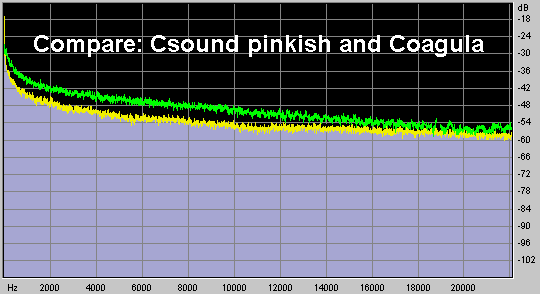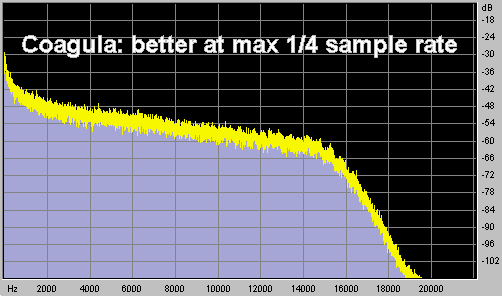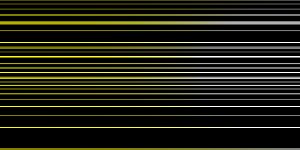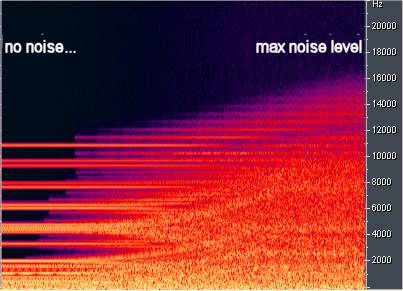
Sinewaves appear as spikes.

The right-hand spectral views were made with a spectral analysis program. They look much compressed downward
since linear frequency representation is commonly used for spectral analysis. Coagula uses exponential frequencies,
like tonal/pitch hearing.
In any case, you can see that the noise is clipped upwards, but tends to generate more lower frequencies. The sweep image (leftmost)
is several lines. The interaction between these close frequencies, together with the noise generates much low-frequency interference.
This works well for most kinds of noise sounds.

Sinewaves appear as spikes.
The gaps between sinewaves correspond to the characteristic organ-like sound.

Noise level next-to-highest (9/10).
This shows that Coagula generates fairly smooth more or less pinkish noise,
a bit uneven at the top range (perhaps due to aliasing).
Note that Coagula noise here doesn't seem very band-limited. As noted, the image render went to 16000 Hz, but the noise continues
all the way up to the highest end. Due to the workings of the noisery, it is better to render no higher than 1/4 of sample rate
(11025 Hz in a 44.1 kHz soundfile). See below.
Anyway you can sculpt the Coagula noise to nearly anything by applying
filters that removes the blue color.

The Coagula noise spectrum (green line) over carefully designed pink noise (yellow line).
The above was generated with Csound's opcode "pinkish," probably one of the better pink noise generators around. As you can see, Coagula noise is more biased to the mid and lower range. This is not all bad, one will often want to filter blue from the highest range anyway.
Note: "Pink" noise means that the amplitude falls off to the high end (by ca 3 dB per octave). This gives equal power in each octave,
which is to say that the noise sounds equally loud in all ranges. White noise (which would be a horizontal band in the images)
sounds much sharper in the higher range.
See further the colors of noise FAQ
Csound is a hacker synth and programming language with all the goods.
See csounds.com

Here is a 32768-point FFT of the same white image rendered with frequency range 20-11025 Hz.
Due to the workings of the Coagula noise algorithms, you get cuter spectrum if you generate no higher than 1/4 of sample rate (11025 Hz in a 44.1 kHz soundfile). Now the sound falls off very quickly above 11 kHz (-60 dB in an octave is almost a "brickwall" when sound engineer people talk filters.)
 =>
=> 
The white gradually increases, expanding the noise bands.
On the other hand, all-white images are perhaps one of the least interesting things to render with Coagula.
In later versions there will be more control over Coagula's noise machinery.
Today it is a fast, highly cooked mix of modulations, and you can already make quite a variety
of noise sounds.